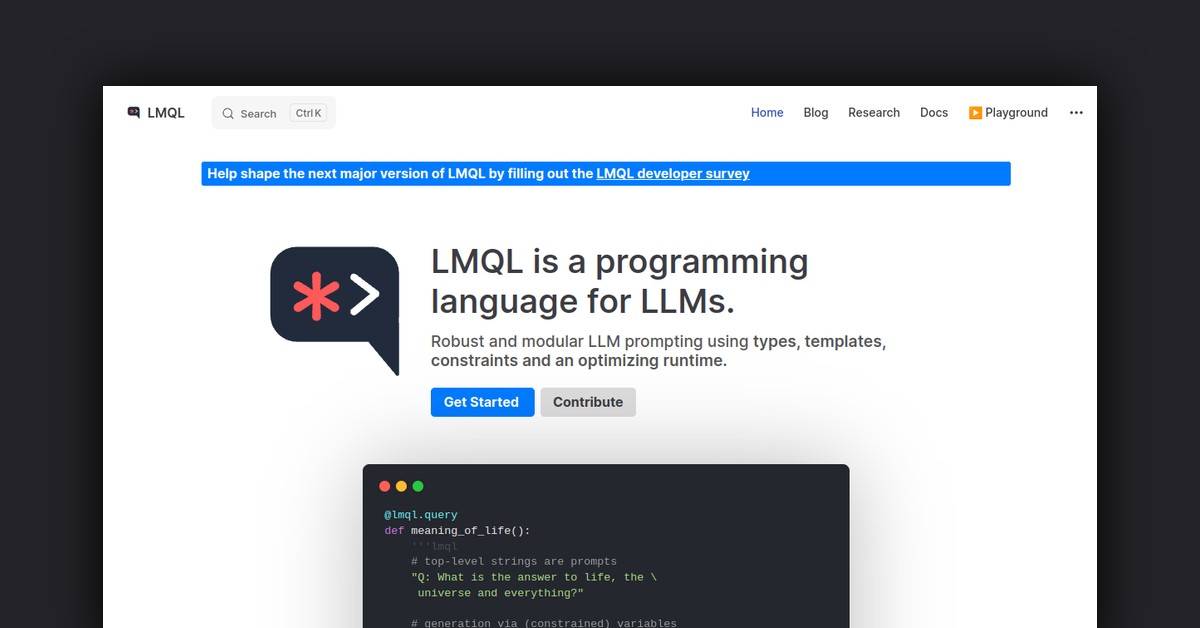Unlocking the Power of Large Language Models with LMQL
LMQL (Language Model Query Language) is an innovative programming language that empowers developers to seamlessly interact with large language models like GPT-3. Created by researchers at the Secure, Reliable, and Intelligent Systems Lab (SRI Lab) at ETH Zurich, LMQL offers a game-changing approach to leveraging the capabilities of these advanced AI systems.
Bridging the Gap with Language Model Programming (LMP)
LMQL bridges the gap between natural language and programming by allowing users to craft scripted prompts that combine intuitive language instructions with Python code. This unique approach, dubbed Language Model Programming (LMP), makes it effortless to adapt language models for a wide range of tasks while maintaining high accuracy.
Unleashing the Power of LMQL
At the core of LMQL’s functionality is its ability to convert user queries into efficient inference procedures that minimize expensive calls to the underlying language model API. This is achieved through innovative partial evaluation techniques, ensuring optimal performance and resource utilization.
Key Features and Benefits
- Scripted Prompts: Seamlessly integrate natural language and Python code for expressive prompting.
- Constraints: Specify logical constraints over the language model’s output to ensure robustness and reliability.
- Control Flow: Leverage Python’s control structures, such as loops and conditionals, to precisely control the generation process.
- Efficiency: LMQL’s query optimization techniques can reduce language model calls by up to 80%.
- Debugging: Inspect interpreter state and model hypotheses during query execution for enhanced transparency and understanding.
- Portability: LMQL abstracts over model internals, allowing queries to work across different language models.
- Interaction: Easily incorporate user input, calculators, APIs, and other external resources into the prompting process.
Unlocking a Diverse Range of Capabilities
LMQL’s versatility shines through its broad range of applications, including:
- Question Answering: Retrieve accurate answers from language models by posing targeted questions.
- Summarization: Generate concise summaries of documents, articles, and other content.
- Data Augmentation: Create additional training examples to strengthen machine learning models.
- Creative Writing: Unleash the language model’s creativity for stories, lyrics, scripts, and more.
- Chatbots: Build conversational agents with natural and engaging dialogues.
- Search: Integrate seamless search functionality over external data sources like Wikipedia.
- Calculations: Perform complex calculations as part of the language model’s reasoning process.
Getting Started with LMQL
Explore the power of LMQL through the following resources:
- Playground IDE: A web-based editor for hands-on experimentation with LMQL.
- Python Package: Install the
lmqlpackage viapip install lmqlto run LMQL locally. - Documentation: Comprehensive guides and API references to help you get started.
LMQL is an open-source project licensed under the MIT license, and the researchers welcome contributions and feedback through the GitHub repository.
Unlock the True Potential of Large Language Models
LMQL presents a transformative approach to working with large language models, empowering developers to unleash their full potential. By seamlessly integrating natural language and Python, LMQL simplifies the process of adapting these powerful AI systems for a wide range of applications. Embrace the future of language model interaction with LMQL and unlock new possibilities in your development endeavors.



